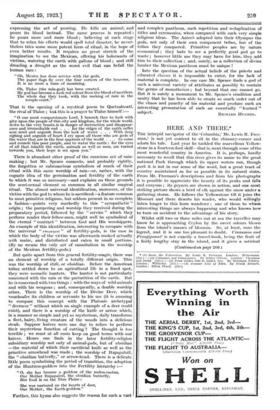HERE AND THERE.*
THE intrepid navigator of the 'Columbia,' Mr. Lewis R. Free. - man,' is not yet content to sit in the chimney-corner and adorn his tale. Last year he tackled the marvellous Yellow- stone in a fourteen-foot skiff—that is, went through some of the most wonderful country in America. It is, perhaps, hardly necessary to recall that this river gives its name to the great national Park through which its upper waters run, though park it is not in our sense of the word, but a great tract of country maintained as far as possible in its natural state.
From Mr. Freeman's descriptions and from his photographs it is possible to appreciate the beauty of its peaks and falls and canyons ; its geysers are shown in action, and one most striking picture shows a herd of elk against the snow under a gathering storm. He follows the Yellowstone till it joins the Missouri and there deserts his reader, who would willingly listen longer to this born wanderer : one of those to whom interesting things are always happening and who knows how to turn an accident to the advantage of his story.
Whilst still two or three miles out at sea the traveller may know he is approaching Ceylon by the sweet odours blown from the island's masses of blossom. So, at least, runs the legend, and it is one too pleasant to doubt. Cinnamon and Frangipanni2 is not exactly a travel-book, being the fruit of a fairly lengthy stay in the island, and it gives a satirical (Continued on page 2(10.) (I) Down the Yellowstone. By Lewis R. Freeman. London: Heinemann [21s.]—(2) Cinnamon and Eranoinanni. By Ashley Gibson. London : Chapman and Dodd. (21s.)—(3) From Golden Gate to Golden Sun. By Hermann Norden. London: Witherby. 115s.)—(4) Summer Isles of Eden. By Frank Burnett. London: Sitton Freed. P21s.)
sketch of the European colony besides its description of the native civilization and wild life which is the most valuable part of the book. Mr. Gibson's first-hand acquaintance with the buried cities, of which Anuradhapura is the best known, aided by some admirable photographs, dispels the too-extrava- gant expectations with which ignorance invests these wonderful relics ; but even now the degree of civilization to which their size and beauty testify surpasses anything anticipated. The adaptations from the Mahavansa are tedious, but told more briefly might have been charming, and the style in general suffers from excessive heartiness.
From Golden Gate to Golden Sun' has more anthropological interest than either book mentioned above. Though it could stand on its merits as a tale of adventurous travel in Siam and Malaya, many readers probably will not be content to leave it at that, but may find a more serious pleasure in the author's accounts of native laws and customs. The Malayan's theory of detrimental punishment is rather curious—the crime is punished by cooking and eating the son of the offender, who is present himself as a guest. It is a subtle plan which might perhaps fail in a more sophisticated community.
Mr. Burnett is a veteran collector of Polynesian trophies, and he probably knows the South Seas better than many Londoners know the East End. In the present volume.' he extends his route into Borneo, and records a great deal of information about the intimate life of the natives in a manner which is neither bald science• nor popular clap-trap, but simple, kindly observation. The notorious Dyaks, the head- hunters, were among his acquaintances. The eighty illustra- tions are admirably chosen and full of interest. One of the most remarkable shows a town of several thousand inhabitants built entirely on piles in the waters of a lake.



































 Previous page
Previous page